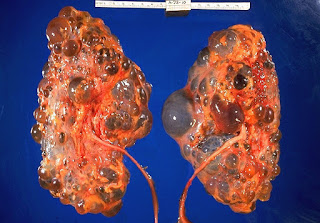Polycystic Kidney Disease (PKD): Causes, Symptoms, Diagnosis and Teatment
Polycystic kidney disease (PKD) is a genetic disorder. Multiple clear or brown fluid-filled cysts are formed in the kidney in PKD. The growth of these cysts leads to loss of normal kidney structure and functions and eventually causes kidney failure. Many other complications like hypertension and cysts formation in the liver may develop.
 |
Symptoms of Polycystic Kidney disease
The majority of patients of polycystic kidney disease remains asymptomatic earlier for many years. Usually, symptoms appear after 40 years of age. Symptoms of PKD are involved -
- Bilateral renal mass in the abdomen
- Hematuria (blood in urine) due to cyst rupture
- Back or flank pain
- Urinary tract infections
- Pyelonephritis
- Renal stones
- Hypertension
- Rarely proteinuria
Causes of Polycystic Kidney Disease
PKD is mostly caused by abnormalities in genes and rarely by acquired defects. There are three types of PKD -
(1) Autosomal dominant polycystic kidney disease (ADPKD)
ADPKD is caused by mutations in PKD1 and PKD2 genes. Symptoms of ADPKD generally appear between 30 to 40 years of age. If a parent has the disease, then the probability of having a disease in children is 50%.
(2) Autosomal recessive polycystic kidney disease (ARPKD)
ARPKD is hereditary renal disease of childhood. it is very rare than ADPKD. Mutations in the PKHD1 gene are responsible for ARPKD. For having the disease in children one gene of ARPKD from each parent must be transferred to their offsprings.
(3) Acquired cystic kidney disease
It develops in people who have already kidney diseases. It is not inherited.
Complications of Polycystic kidney disease
Following are the complications associated with PKD-
- Brain aneurysm
- Cyst in the liver, pancreas
- Diverticulum in colon
- Systemic hypertension
- Renal stones
- Renal failure
- Preeclampsia in pregnant women
- Cardiac abnormalities like Mitral valve prolapse
Diagnosis of the Polycystic kidney disease
Diagnosis is made on the basis of positive family history and following investigations -
- Ultrasonography confirms the presence of cysts
- Intravenous urogram shows spider leg pattern
- CBC is done for identifying the presence of any infections and anaemia
- Urine examination to detect protein, blood or any cells in the urine.
- Serum creatinine
- Abdominal CT scan and MRI
Treatment of Polycystic Kidney disease
There is no specific treatment is available to reduce cyst growth. The main focus of treatment is on slowing renal disease progression and lowering cardiovascular risk.
Some treatment options are -
Some treatment options are -
- Blood pressure is controlled by medication
- Analgesics for pain
- Adequate hydration to prevent renal stone
- Antibacterial therapy for Infections.
- Surgical interventions to remove cysts.
Comments
Post a Comment